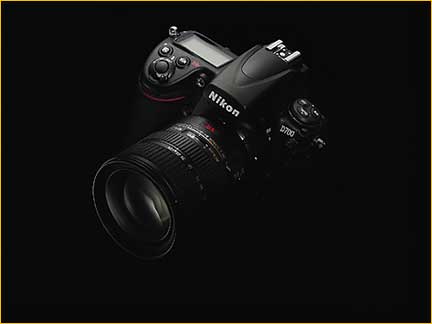
The What
TheNikon D700, announced on 1 July, ’08, and scheduled to ship by the end of this month, is a bit of a shocker, and indicative of a new, much more aggressive Nikon than we have been accustomed to during this digital decade.
In brief, it is a full-frame (FX) camera using the same 12 MP sensor and image processing electronics as in the Nikon D3, except in a body closer in size and weight to the Nikon D300. Remarkably, the D700 has as much as 95% of the goodness of the D3 in a camera that costs some $2,000 less. If that isn’t aggressive, I don’t know what is.
Unlike some other camera companies (you know who I mean), Nikon doesn’t reduce build quality, features and functionality on its second tier cameras. This means that except for a few items, such as a single rather than dual card slots, and the lack of audio note recording, the D700 has virtually every feature of the D3. It even ups the ante by adding a pop-up flash unit (which nicely serves as a remote flash trigger with Nikon Speedlights), and dust removal sensor shake, something that’s nowde rigueuron all new cameras, but which was lacking on the D3.
Of course because the body is a lot smaller than a D3 and just slightly bigger than a D300, it lacks a vertical grip and release, but this can be remedied through the addition of an optional MB-D10 battery grip.
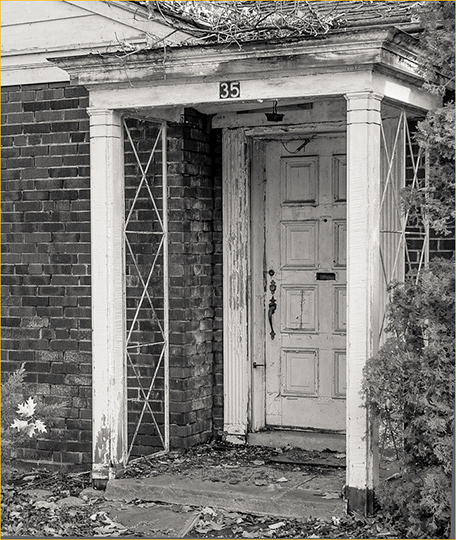
Abandoned. Holland Marsh, Ontario. July, 2008
Nikon D700 with 200-400 f/4 VR lens @ ISO 200
_________________________________________________________________
The Competition
The Nikon D700 appears to be an arrow aimed right at the heart of the Canon 5D’s constituency, the only other traditional-sized full frame DSLR on the market. The problem with this comparison though is that the 5D is now three years old and long past its best-before date. Its replacement is due any day now (certainly by Photokina in late September). It’s therefore impossible at this point to know how successful the D700 will be against its as yet unreleased competitor. (You can be sure that I’ll be doing a head to head comparison here against the D700 when the new 5D comes out).
Against the current 5D though it’s simply not much of a contest. The D700 is at least one and possibly two generations more advanced in terms of low noise / high ISO capability, and arguably somewhat better in general IQ as well. In terms of build quality and features it also offers considerably more than Canon’s current offering.
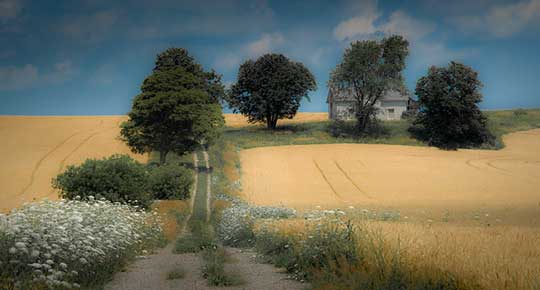
House on The Hill. Ontario, July, 2008
Nikon D700 with 24-120 VR Lens at ISO 200
_________________________________________________________________
The Differences
Because the D700 has the same sensor and imaging electronics as the flagship D3 it needs to be seen in direct comparison with its bigger brother, especially considering the $2,000 price difference. But, it doesn’t take a table of differences with endless lists of specs and features to highlight what is different between them.
The D3 will do up to 9 FPS, and the D700 can shoot at up to 5 FPS, though with the MB-D10 battery grip (the same as the one used with the D300) the D700 can get close, with up to 8 FPS possible. For most photographers, excepting sports and wildlife shooters, 5 FPS is usually sufficient, and certainly 8FPS is likely to fill the bill. But for those that need to eke out the highest possible speed, by setting the D3 to DX mode, up to 11 FPS is possible, so the D3 still retains an edge in this area.
The D3 provides an integral vertical grip, release and controls, whereas the D700 can have these added by attaching the accessory grip. (They’re there when you need them and not when they’re not, reducing bulk and weight).
As already mentioned the D3 offers a built-in mike and speaker for audio notes; the D700 does not. On the other hand the D700 has a sensor shake dust removal system which the D3 does not. And, the D700 has a built-in pop-up flash, which the D3 does not. Many pros as well as amateurs appreciate this, not just as an occasional fill-in but also as an always available remote flash trigger.
As part of the trade-off for smaller size and weight the D700’s viewfinder provides just 95% coverage rather than the 100% of the D3. The D3 also uses a larger, higher capacity battery than the D700, and so one can expect not just higher frame rates but longer battery life as well.
When it comes to weather resistance and build quality the cameras are pretty comparable (which means rubber gaskets and a high degree of weather sealing), though the D3’s shutter mechanism has a higher longevity rating, in fact double that of the D700.
The smaller size and lower weight of the D700 will be a considerable factor for some photographers. A good as the D3 is, it’s a big camera, and for smaller people can be quite a handful. I was reminded by someone last week that there are a lot of woman photographers who photograph weddings, and that assignment means long days and hundreds if not thousands of hand-held exposures. A less bulky camera than the D3, offering equal image quality, will therefore be appealing. Anyone who hikes, climbs, or needs to travel very light will similarly welcome a reduction in weight and bulk.
And though the D700 is a pro-spec camera, with robust construction and weather sealing, for the working pro who shoots thousands of frames a month, the 300,000 actuation rated shutter mechanism of the D3 will in the long run turn out to be worth consideration. (But one can also argue that at the price one can almost buy two D700s for every D3, thus increasing versatility and spreading the load, not to mention general wear and tear).
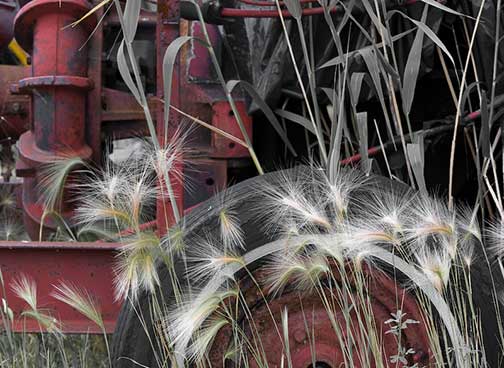
Red Tractor. Holland Marsh, Ontario. July,2008
Nikon D700 with 200-400 f/4 VR lens @ ISO 1400
UPDATE
Since this review first appeared there has been some discussion and debate as to why I didn’t mention the D700’s autofocus performance. The reason is simple – just as with the sensor and autoexposure system, the D700’s autofocus is identical to that of the D3, so there really isn’t anything new to say. People seem to be looking for problems and issues where there really aren’t any.
_________________________________________________________________
In Hand
If you have ever used or even held a Nikon D300 then you have a pretty good idea of what the D700 is like. The D700 is a bit more massive and slightly bulkier, but not enough so as to be a factor for most people.
The basic gestalt of this body design is well established, with Nikon’s traditional handling and features. The LCD is Nikon’s latest high resolution screen, both bright and sharp. The D700 features Nikon’s current iteration of Live View, with both contrast detection and phase detection focusing modes, and there is even a new availability of the heads-up level display during Live View (now available as a downloadable firmware upgrade for D3 owners).
The D700 features all the rest of Nikon’s top shooting features, including 14 bit A/D conversion, 51 point autofocus with 15 cross type sensors, and sophisticated 1005 pixel AE sensor. The camera turns on almost instantly and the shutter release is as responsive as any on the market.
The only design aspect with which I have any concern is the CF card slot door, which, unlike the D300 and the D3, no longer has a latching lever, but instead slides back and outwards with a friction lock. Nothing inherently wrong with this, but it seems just a bit less secure than the lever design.
The D700 is by no means a small camera, certainly not in the sense that the latest generation of reduced size DLSRs are. But compared to the D3, which one can regard as comparable to the D700 in most regards except for form factor, the D700 is a much more manageable handfull than the D3.
Conversely, there will be photographers who value the added mass of the D3, such as when using large lenses on a gimbal mount, where the counterbalancing effect is needed. And of course those with large hands may simply enjoy the heft of the larger camera.
_________________________________________________________________
Image Quality
Let’s clarify something up front for those on web forums that are nattering about the D700’s image quality, even though the camera hasn’t yet shipped. Relax, you’ve already seen it! Since the camera uses the exact same sensor and support electronics, if you know what a D3’s image quality looks like, you know what a D700’s output is like. It’s as simple as that. And, in case you’ve have been under a rock for the past year, that means among the lowest noise and otherwise highest image quality of any camera.
At any sensitivity up to ISO 1600 there’s little of concern in terms of low noise. Uncanny. At ISO 3200 a slight bit of luminance noise appears, but it can be easily removed in post. ISO 6400 is still eminently usable, and even ISO 12,000 equivalent is acceptable for reportage. Truly amazing is that ISO 25,000 equivalent, though noisy, is no worse than Tri-X used to be at ISO 1,200.
Dynamic range and colour purity is first rate. The D700’s large 8 micron pixels ensure a very high signal to noise ratio and these clean pixels really allow for more ressing up when needed than one would think. I have made 24X36" prints from the D3 that are hanging in my gallery alongside images taken with a 21 Megapixel 1Ds MKIII, and one has to struggle to determine that those from the D3 were done with nearly half the resolution of those from the Canon. Results from the D700 will be similar, but remember – to get the best from this or any camera takes optimum shooting technique.
Image-wise the D700’s only real shortcoming is its 12MP sensor. Notwithstanding my comments above, If you’re someone that needs more than 12MP you’ll have to wait for the upcoming Nikon D3x, expected later this year in a D3 style body with some 24 megapixels, and a price tag to match.
I could go on for pages about the D700’s image quality. But I won’t, for several reasons. I’m going to hold off until Canon’s 5D replacement is available, because it’s by comparing two state-of-the-art cameras that we’ll really find interesting things to examine and debate.
More to the point, reviewing the D700’s image quality would be redundant, because as written above, it’s simply the same as the D3. You can read detailed analysis of the D3’s image quality on a number of sites and magazines. If you want tecky analysis then look no further thanDPReview,and if you want a photographer’s analysis then respected independent Nikon authorThom Hogan‘s site isthe place to go.
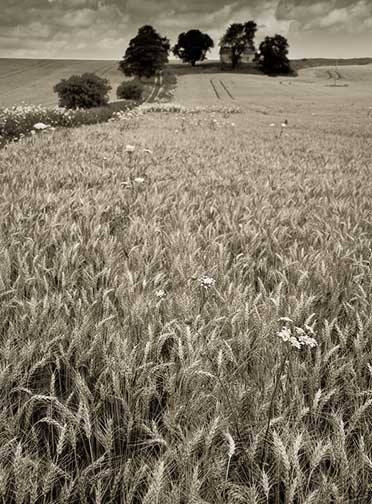
Wheat Field. Ontario. July, 2008
Nikon D700 with 24-120 VR Lens at ISO 200
_________________________________________________________________
The Why
Which, of course, brings us to the $64,000 question –why? Why would Nikon produce a smaller and lighter camera, with identical image quality and almost identical feature set to its current flagship camera (and even some desirable additional features) for about two thousand dollars less?
I’m not sure that I or anyone outside of Nikon has a cogent answer. On the one hand, the D700 appears to cannibalize the D3’s higher margin sales. On the other, at its lower price point and likely appeal to a broader market segment it will generate significantly higher sales volumes.
If one looks at the D3 on its own what we see is a brilliant camera with some unique capabilities, but one which will soon be eclipsed by its forthcoming big brother, the D3x (assuming that’s what it will be called). Though the D3x will not have the high frame rates and remarkable high ISO capabilities of the D3, due to its class-leading high resolution (likely 24MP) it will become the camera of choice for many photographers seeking the top-level Nikon body. This will almost certainly reduce the D3’s appeal to all except the professional sports and photojournalist markets, that camera’s natural constituency.
One only has to look at the relationship between the Canon 1D MKIII and the 1Ds MKIII to see what Nikon has in mind. Now, figure that Canon will be bringing out its successor to the now ancient 5D within the next couple of months. Though we don’t know what mix of features and sensor resolution the new 5D will offer it will likely be in the 16MP range. This gives Nikon an interesting challenger in this market segment, one which Nikon will be unable to best in the short term with a higher resolution chip than 12MP (though this will obviously come eventually). Instead, I believe that Nikon has decided to meet the new Canon 5D’s challenge through offering a better built, higher spec, more full-featured camera with the D700, letting megapixels not be the determining factor in this race.
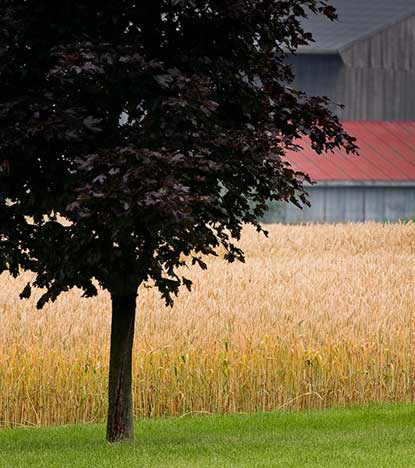
Tree and Red Roof, Ontario. July, 2008
Nikon D700 with 200-400 f/4 VR lens @ ISO 1800
_________________________________________________________________
The Camera and The Kit
The D700 is available in the US at $2,999 (body only) and for $3,599 as a kit with the 24-120mm VR lens. Until the initial feeding frenzy is over the price is likely to remain as set, with discounting really starting only toward the holiday season.
For most photographers who are already owners of Nikon lenses I would suggest against purchasing the kit. The 24-120mm VR is not that good a lens. Yes, it’s versatile, but whenever I use it it disappoints in terms of image quality. To put this underperformer on what is among the highest image quality cameras yet is doing the camera an injustice. The D700 really deserves to be used with the highest qualty lenses.
If you’re just stepping into the Nikon world and need something to get started with, then fine, at $600 when bought as a kit the lens is cheap enough, and versatile enough. But save your pennies and get a really good quality lens as soon as possible so that you can see what the D700 is really capable of.
_________________________________________________________________
The Choices
The D700 presents a Nikon user (or a prospective one) with some interesting choices. The camera’s mixed DNA, part D3 and part D300, makes both of these other cameras interesting alternatives.
All three offer essentially the same 12 megapixel resolution along with very similar shooting features and functions. In terms of current US pricing the D3 is about US $5,000, the D700 $3,000, and the D300 about $1,700.
Of course both the D3 and D700 are full frame (FX), while the D300 is reduced frame (DX), with a 1.5X factor lens magnification. Since they have the same effective resolution, it would appear that for those photographers with a preference for shooting with long lenses the D300 might be a better choice, at least so long as ISOs under about 1600 are used.
Naturally, the D700 or D3 would be preferable for those shooting wide, since regular full frame wide lenses, like the remarkable new 14-24mm Nikkor, can be used. (Now that Nikon has FX cameras, and presumably with more and less costly ones on the way eventually, I would be hesitant to buy DX lenses any longer. They could end up being dead-end investments).
So? Which camera to buy? A D3, a D300 or a D700?
My take is that if you need the highest image quality, with the highest ISO capability, fastest frame rates, most rugged shutter, a vertical grip and release, and longest battery life, along with audio note taking and dual card backup capability, the choice has to be the D3.
If smaller size, weight, and bulk are important, then the choice narrows. High ISO? Go for the D700 and get 95% of the D3’s goodness along with a saving of $2,000. No need for ultra-high ISO, on a budget, and do a lot of long lens shooting? Then, the D300 is a compelling choice.
I would suggest that a two camera kit consisting of a D300 and a D700 is almost ideal. They can share batteries and the vertical grip as well, making for a very versatile package, and in combination with the MB-D10 battery grip cost about the same as a D3 alone. That would be my recommendation.
But when the D3x comes along I’d argue that it plus a D700 will form an ideal combo. The D700 for high ISO shooting, and with the grip, frame rates up to 8 FPS. The D3x for higher resolution, more robust shutter, and other goodies.
Either way, unless you’re a Nikon owner who is already invested in a D3, a D700 is an ideal camera to have as part of an ultimate Nikon kit.
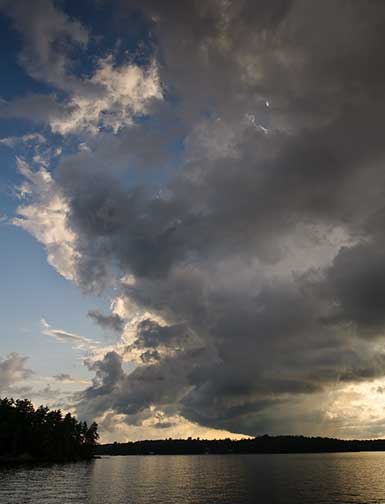
Clearing Storm. Muskoka, Ontario. July, 2008
Nikon D700 with 14-24mm @ ISO 200
_________________________________________________________________
NB:
The photographs on this page were all taken with a production Nikon D700 and a variety of lenses. They were not taken with the purpose of showing any particular aspect of image quality, and indeed some have had adjustments applied to them which may have actually decreased apparent image quality for creative purposes.
July, 2008
You May Also Enjoy...
Pixel Count
How Big is Too Small?Ever since digital SLRs came on the scene almost a decade ago manufacturers and photographers have shared two goals — more
Is MF Dead
© 2013 The Luminous Landscape Inc. All Rights ReservedPeople love to gossip, and few topics are as rife these days as the impending death

